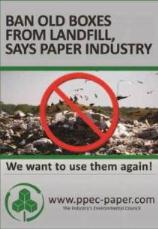The Ontario Ministry of Environment and Climate Change (MOECC) is quietly preparing the groundwork for some long-delayed action on printed paper and packaging in the industrial, commercial and institutional (IC & I) sector. Specifically, it wants a report by mid-March on the cost impacts and economic and greenhouse gas reduction benefits of diverting an additional 1,000 tonnes.[1]
Printed paper and packaging are good targets to start with because neither of them should be ending up in landfill, whether in Ontario or across the border in Michigan or New York State. Printing and writing paper and old corrugated boxes (OCC) are perfectly recyclable, and have enjoyed solid end-markets for decades. We want them back!
The ministry appears to be toying with two different approaches to achieve this: what it calls a producer responsibility framework and a generator responsibility framework. We are familiar with the producer responsibility framework enunciated in the ministry’s recent Waste Reduction Strategy document,[2] but frankly, without pre-judging what the ministry finds in its current study, we would prefer the generator model.
One of the problems with IC & I waste generally, is the lack of good data. Producers are often one step removed from what happens with waste, which can lead to the creation of an unnecessary bureaucracy to handle it. Generators, on the other hand, are right there on the spot, making the decision whether to recycle or dump. They are also repositories of much sought after data (or could be). We know, for example, that old corrugated boxes sent for recycling from the back of a supermarket directly to a paper recycling mill or to its processor agent, are not included in the current Statistics Canada surveys of waste. Statistics Canada only counts tonnages sent through waste haulers.[3] Adopting a generator responsibility model (with appropriate exemptions for small operators) would not only provide data we currently don’t have in Ontario, it would also appear to be the more cost-efficient option.

But it’s not the only option. PPEC lobbied the previous minister of environment to ban old corrugated boxes from landfill back in June 2012.[4] We estimated then that banning just OCC from landfill in both Ontario and Quebec would reduce greenhouse gas emissions by as much as 85,000 tonnes, or the equivalent of taking 15,000 vehicles off the road. A provincial ban on OCC would also extend the life of existing Ontario landfills by two and a half years, delaying costly measures to find new, always hard to site landfills as the current ones rapidly fill. We estimated that Ontario and Quebec municipalities would also benefit, achieving operational cost savings of between $12 million and $18 million.
There is a good case to be made for both the generator model and landfill bans. We will be making both, in the months ahead.
[1] Ontario MOECC Request for Proposals: A Study on the Cost Impacts and Economic and Greenhouse Gas Benefits of Waste Diversion of Selected Waste Materials in Ontario.
[2] Waste Reduction Strategy, Ontario MOE, June 2013.
[3] Statistics Canada (WMIS) 2010 disclaimers: “These data do not include those materials transported by the generator directly to secondary processors, such as pulp and paper mills while bypassing entirely any firm or local government involved in waste management activities” (p.17). “Some non-residential waste is managed on-site by industrial generators. Also, some waste is transported by the generator directly to secondary processors. These practices are not currently accounted for by these surveys despite anecdotal evidence suggesting that they are becoming increasingly common” (p.33). “These data do not include those materials managed by wholesalers of scrap metal, plastics or paper. As with the other data in this report, these data cover only those firms whose primary source of income accrues from waste management activities and those public bodies that provide waste management services” (p.35).
[4] Paper industry wants old boxes banned from landfill, PPEC press release and backgrounder, June 18, 2012.
